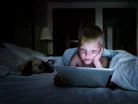50% of Teens to be Affected by Myopia Globally by 2050

Myopia - short sightedness - could affect more than half of teenagers in the world by 2050, according to research published in the British Journal of Ophthalmology.
Research involved over five million children and teenagers from 50 countries across all six continents, which revealed that short-sightedness has tripled from 1990 to 2023.
The researchers pointed to the COVID-19 lockdowns as one cause for the rise, when children were given more screen time.
Results showed short-sightedness was present in:
- 85% of children in Japan
- 73% in South Korea
- 40% in China and Russia
- 15% in the UK, Ireland and the US
- 1% of children in Paraguay and Uganda
How education, screen time and geography can lead to myopia
Myopia often begins in primary school and worsens until the eye has stopped growing, at around 20 years old.
- Struggling to read words from a distance
- Having to view a screen from very close to the face
- Getting headaches
- Eye irritation and the urge to rub eyes
During the global lockdowns, billions were forced to stay indoors, using screentime as escapism - from watching a comfort movie, indulging in a new documentary, building a social media following or reading the latest news on COVID.
Many parents worked from home and relied on screens as a babysitting tool. For many families, screen time is a way to keep children seen and not heard. But that screen time is not without consequences for those children and teenagers, as evidence suggests a potential association between the pandemic and accelerated vision deterioration among young adults.
However, myopia is also geographically influenced by when and where a child starts school.
In the classroom, children focus their eyes on books, screens and whiteboards, which strain eye muscles. This can lead to myopia.
For children living in East Asia, myopia starts early, as does school, from two years old.
In Africa, where myopia is seven times less common than in Asia, school begins at the age of six.
Myopia is also impacted by genetics. The study also suggests that girls are more likely to have myopia than boys, because they spend less time doing outdoor activities.
EssilorLuxottica and understanding myopia
EssilorLuxottica is a major player in vision care. Formed in 2018 through the merger of French company Essilor and Italian company Luxottica, the company is headquartered in Paris, France and Milan, Italy. Its brands include Ray-Ban, Oakley and Vogue Eyewear.
The company employs 193,000 people worldwide and had a 2023 revenue of €25.83bn (US$27bn).
"Myopia, or short-sightedness, is when a child can see close up objects but struggles to see objects far away clearly, such as the whiteboard at school. This typically develops in children of school age and the younger a child becomes myopic, the more likely they will develop higher levels of myopia,” explains Charlotte Timbury, Dispensing Optician and Director of Medical & Professional Affairs for EssilorLuxottica North Europe.
"It's evident that many parents and even those whose children are myopic, lack accurate information about myopia. Worryingly, many think that simply making their child wear glasses with corrective lenses solves the problem, unaware that myopia can progress even with corrective lenses.
"However, there are ways to slow it down with lifestyle changes and wearing a myopia control spectacle lens, such as Essilor Stellest lenses, which will correct myopia and slow down its progression."
Make sure you check out the latest industry news and insights at Healthcare Digital and also sign up to our global conference series - Healthcare LIVE 2025
Healthcare Digital is a BizClik brand
- UNEP: Tackling Climate Change to Decrease Health Issue LoadSustainability
- Vaccines, Dementia & Food: The Week's Top Healthcare StoriesMedical Devices & Pharma
- The Toxic, Food-Borne Chemicals Costing Healthcare TrillionsHospitals
- How Amgen Combines Life-Saving Biotech & SustainabilitySustainability





